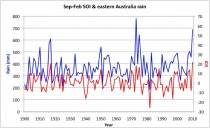By Roger Pielke Jr.
Neville Nicholls is one of Australia’s leading climate scientists. He is also a long-time participant in the IPCC and current president of the Australian Meteorological & Oceanographic Society. I first met Neville in the mid 1990s (at a meeting in Vietnam I think) and I have had nothing but great respect for him ever since. In his latest “AMOS - President’s Column” he asks, “What caused the eastern Australia heavy rains and floods of 2010/11?”
He begins his answer by pointing to the strength of the current record La Nina event and the relationship of the SOI (Southern Oscillation Index, a measure of the strength of La Nina and El Nino events) and Australian rainfall (see his figure above). He concludes:
Given the well-known relationship between the SOI and heavy rains in eastern Australia (eg., McBride and Nicholls, 1983) we can conclude that the fundamental cause of the heavy rains this past six months was indeed this record La Nina event. Other heavy rain years (1917/18, 1950/51, 1973/74, 1975/76) were also the result of strong La Nina events. The relationship between rainfall and the SOI is very strong, with a correlation coefficient of 0.66. So, the heavy rains were not caused by global warming, but by a record La Nina event - a natural fluctuation of the climate system.
But he doesn’t stop there. He next asks: “But perhaps 2010/11 was a record La Nina because of global warming?” His answer:
There has not been any trend in the SOI over the past 111 years, despite the warming of global mean temperature of about 0.75C over that period. Nor do climate models consistently predict increased strength of La Nina events from enhanced atmospheric content of greenhouse gases (eg., Vecchi and Wittenberg, 2010). So there is no reason, at this moment, for us to suspect that global warming is increasing the frequency or intensity of La Nina events.
He doesn’t stop their either, and next asks, “But was the impact of the 2010/11 La Niña on Australian rainfall stronger because of the record warm sea surface temperatures around northern Australia in 2010?” His answer:
These waters have increased substantially over the last century and are now about a degree warmer than early in the 20th century. If these warmer waters were enhancing the impact of La Nina on Australian rainfall we might expect to be seeing heavier rains in recent decades, relative to the rains that accompanied earlier strong La Nina events. There is some evidence of this (eg., Nicholls et al 1996), and there has been a weak tendency towards increased rainfall since 1900, independent of the influence from the El Nino - Southern Oscillation. Perhaps this trend towards increased rainfall might be related to the warmer sea surface temperatures - but much more work is needed to test this. The effect, if there is one, does not look very strong.
He concludes:
The record La Nina event was the fundamental cause of the heavy rains and floods, ie it was a natural fluctuation of the climate system. There may be a global warming signal enhancing this natural variability, but if so then this effect has been quite subtle, at least thus far.
Post. See also Stewart Franks’ story on Jennifer Marohasy’s blog about Better planning for floods in Australia - using ther combination of PDO and La Nina.





